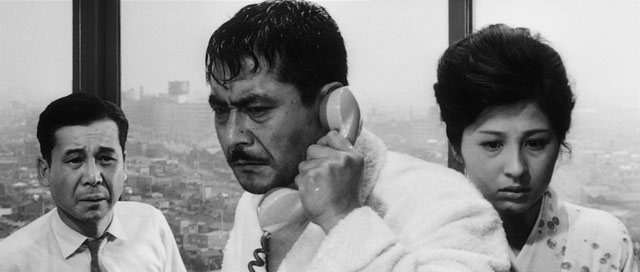To celebrate the upcoming release of my book, Akira Kurosawa: A Viewer’s Guide, due out Dec. 15 from Rowman & Littlefield — preorder here! — I’ll be doing capsule reviews all month covering every single Kurosawa film and posting (very) brief excerpts. These will be short impressions and recommendations, nothing more. For a full, detailed analysis of each, grab the book!
High and Low (1963)
From the very start of his career, Akira Kurosawa was concerned with exploring the class divide, delving into the things that separates the wealthy from the poor. He had perhaps never explored this idea so nakedly as he did in High and Low, called Heaven and Hell in Japan, a film split in two just as the society it depicts is.
Here, Toshiro Mifune plays a business executive plotting a corporate takeover when a kidnapping attempt on his son goes awry. Rather than snatch away his son for a ransom, however, his chauffeur’s son is accidentally taken instead. Mifune struggles with whether or not to pay the ransom, since doing so will sap away the funds he needs for his corporate takeover.
Then the movie takes an abrupt turn, Mifune all but disappearing from screen as the film becomes a police procedural in which the great Tatsuya Nakadai and others try to hunt down the kidnapper, and in doing so explore the way the lower classes live, a stark contrast to the wealth we saw in the first half of the movie.
Yes, that means this is in many ways two films stitched together as one, a movie that, much like Scandal, begins by exploring one idea and ends with another. From the book:
Unlike the thematic misfire of Scandal, however, this split personality is intentional, meant to symbolize the high and low (or heaven and hell) of the title – even the split structure of the film is a manifestation of this – making High and Low one of the director’s most deliberately structured works of social commentary.
High and Low is among the director’s most widely praised works, so this is a case where my personal tastes are at odds with the wider Kurosawa community (something we’ll see with a couple of upcoming movies, too). I think it’s a film with powerful themes but that loses its way a bit, making it a strong but not top-tier work. Many, many others disagree and consider this one of his most masterful efforts … so this is a case where you might want to go with consensus and get it on your short list of Kurosawa’s to see.
Check out my upcoming book for a full analysis exploring this film’s ideas, themes, good points, and bad
You can get the movie in excellent edition by the Criterion Collection.








The post is nicely organized. I see the writer has a true knack
for this particular subject. I like that
subject, and I am in constant search of new pieces and the latest news.
I really enjoyed that one, because it is full of fascinating facts and it is a
kind of easygoing article. I spent just a few minutes reading, and
due to well-structured text, then I know it totally.
Thanks!